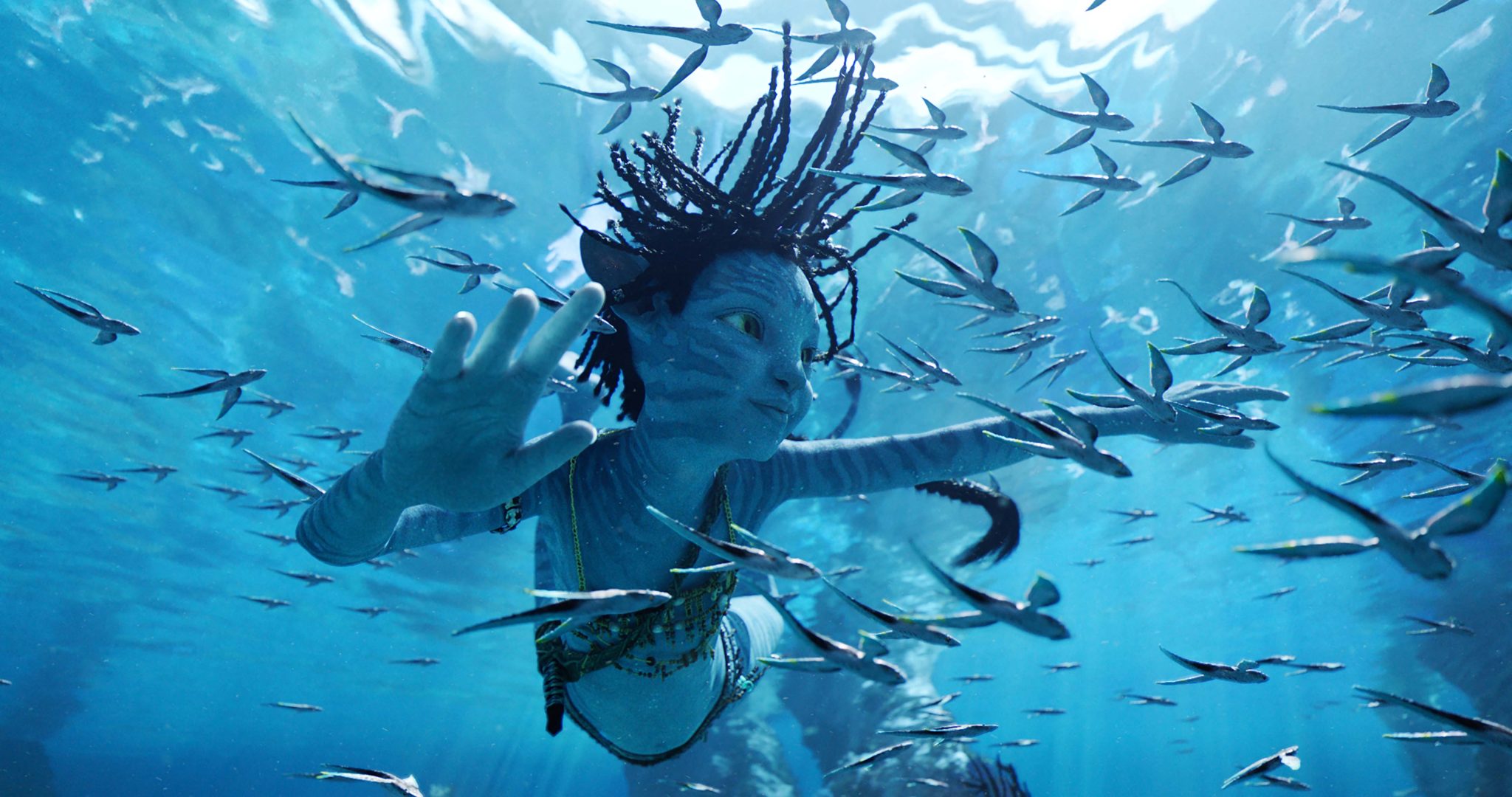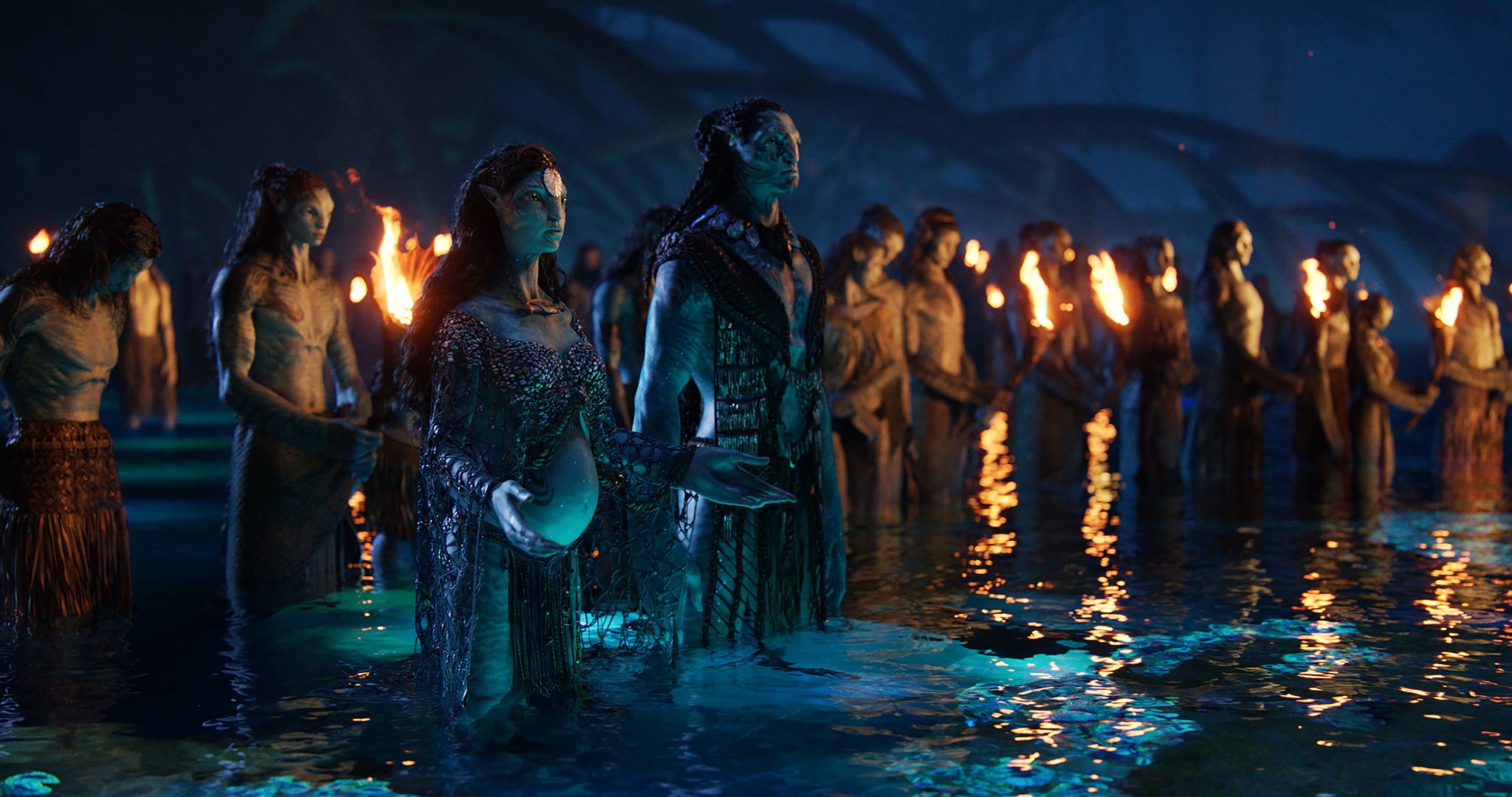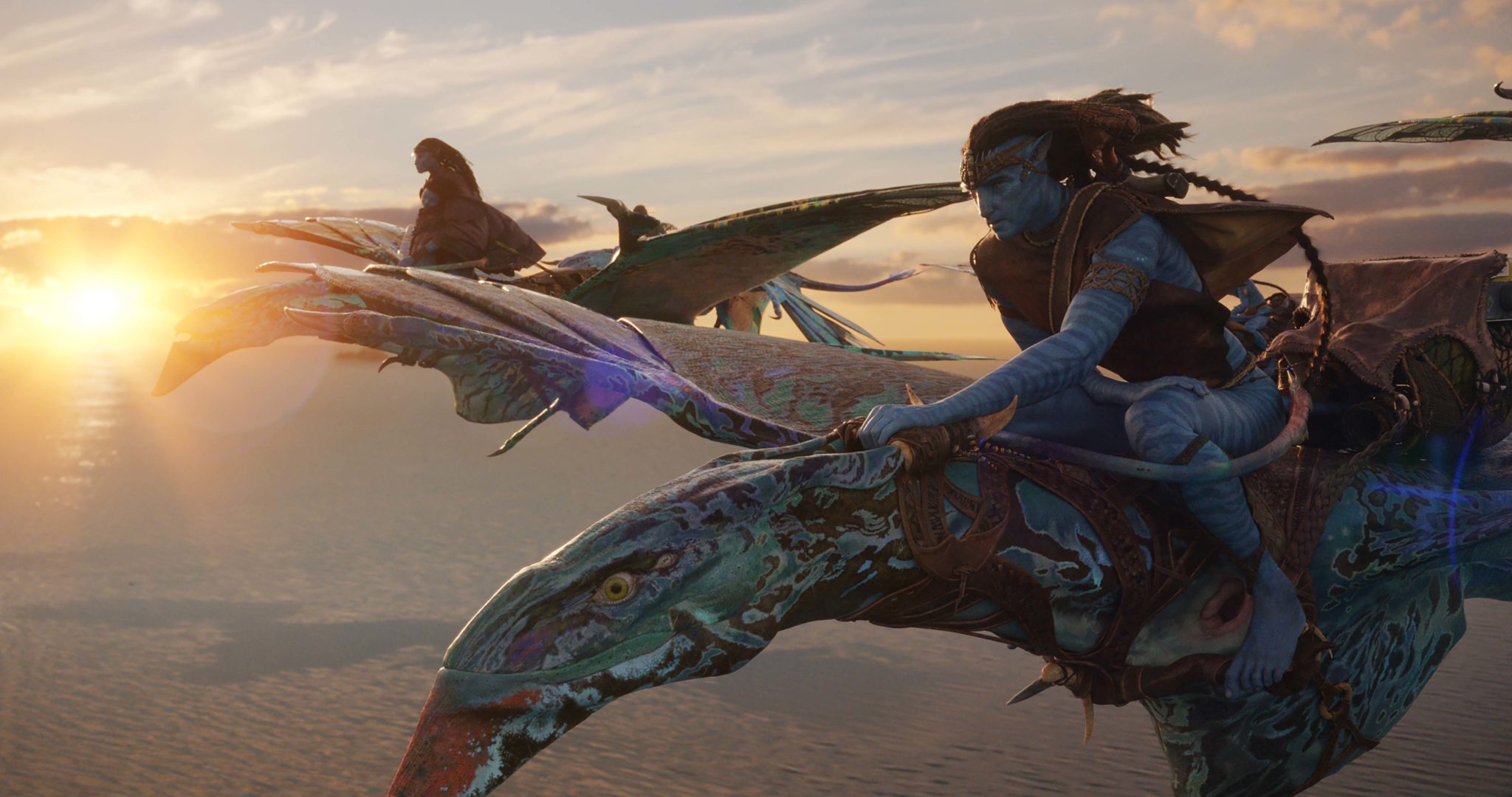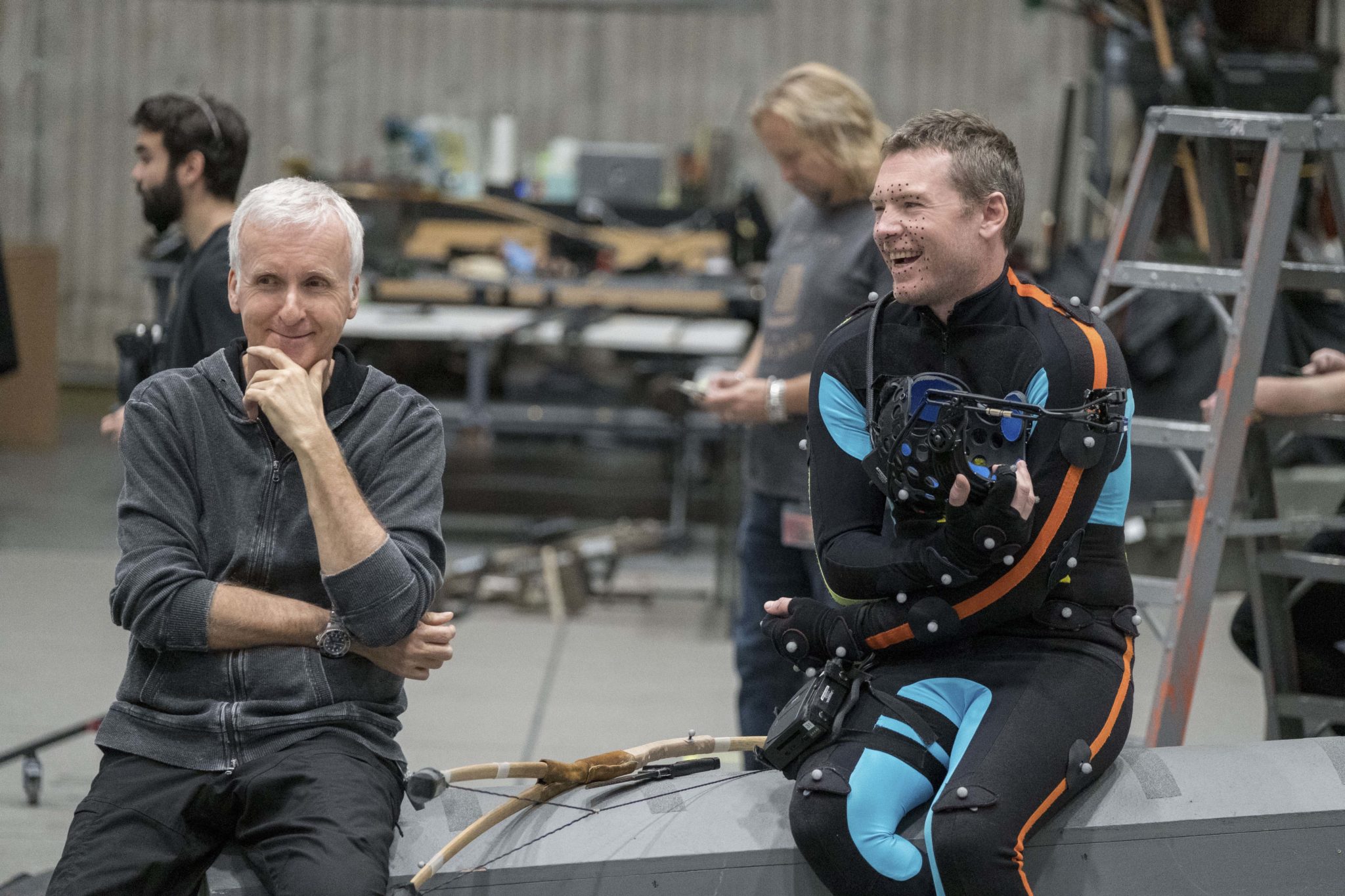- Film And TV
- 06 Jan 23

Having been among the first people in the world to see Avatar: The Way Of Water at a special London screening, Paul Nolan meets the cast and producer Jon Landau to discuss James Cameron’s sci-fi blockbuster – an epic thrill-ride that, as a visual spectacle, sets an incredible new standard.
The Xmas stalls in Leicester Square are doing a roaring trade when Hot Press arrives in early December for a screening of perhaps the year’s most hotly anticipated movie, Avatar: The Way Of Water. For good measure, the screening is kicking off at the time as England’s World Cup clash with Senegal, so for a variety of reasons, there’s a noticeable buzz in the freezing air.
And speaking of the World Cup, a select group of journalists from around the globe are in town for James Cameron’s blockbuster sequel to the biggest grossing movie of all time, 2009’s sci-fi epic Avatar, the box office take of which now stands at a cool $2.9bn.
Outside Odeon Luxe, your correspondent joins a queue of other journalists from all over Europe, as well as America, China, Australia, New Zealand and perhaps elsewhere in the galaxy (which would be fitting given the movie’s subject matter, and besides, would you put it past Cameron?)
Having waited patiently behind the man from Esquire, I finally make it inside and sign the obligatory form agreeing not to leak info about the movie. As I’m taking the escalator down to the screening room, a giddy rush of excitement comes over me – the kind of feeling I’d almost completely left behind during those miserable two years of the pandemic, when communal events were a no-go. I’d missed this rush! What a true delight to finally be able to say: fuck you Covid, it’s payback time.
Advertisement
 Tuk (Trinity Bliss) in 20th Century Studios' AVATAR: THE WAY OF WATER. Photo courtesy of 20th Century Studios. © 2022 20th Century Studios. All Rights Reserved.
Tuk (Trinity Bliss) in 20th Century Studios' AVATAR: THE WAY OF WATER. Photo courtesy of 20th Century Studios. © 2022 20th Century Studios. All Rights Reserved.A few of us in the audience are old enough to remember when Cameron first went truly supernova with another sequel, 1991’s Terminator 2: Judgement Day – a masterpiece of action film-making, which remains one of the most electrifying cinematic thrill-rides you could ever experience. In the time since, Cameron has somehow managed to up the ante with each new venture, from 1997’s Titanic (also in its day the highest grossing movie of all time), to the first instalment of Avatar.
As Arnold Schwarzenegger – whose iconic status was sealed by the Terminator movies – once quipped: “I was lucky enough to do a few movies with James back in the ’80s and ’90s. Of course, that was during his low-budget arthouse days.”
Even by his own standards, Cameron has outdone himself this time round. Thirteen years in the making – including a few delays attributable to Covid – Avatar: The Way Of Water, according to some estimates, cost an eye-watering $400 million to produce, making it one of the most expensive films ever made. To put it mildly, the Canadian director believes in going hard or going home.
To ratchet up the excitement still further, after we’ve been handed our 3D glasses and taken our seats in the Odeon, it’s revealed that we’re the first people in the world to see the film – which I hadn’t been aware of before before the screening. The lights then dim: it’s finally time to embark on Cameron’s space odyssey.
With Sam Worthington reprising his role as Jake Sully – who befriended the Na’vi inhabitants of the moon Pandora in the first movie – the basic plot sees Jake recommencing battle with the villainous Colonel Miles Quaritch (Stephen Lang), who leads the human organisation RDA in colonising Pandora.
Quaritch’s unwelcome reappearance causes the Sully family to flee to flee to territory held by the Metkayina clan, who live in harmony with the surrounding oceans. The Sullys simultaneously learn to navigate the treacherous waters and integrate with their hosts, before the inevitable climactic battle with Quaritch and the RDA forces.
Advertisement
On a purely technical level, The Way Of Water is one of the most visually astonishing movies I’ve ever seen. Cameron has finessed the 3D technology to such an extent that the underwater action sequences (for which the actors received specialised training) now seem to actually emerge from the screen and – I’m not exaggerating here – take place in the cinema.
Later, producer Jon Landau will tell Hot Press that during special test screenings of preview footage, audience members have been trying to reach out and touch the fish. It genuinely is that wild (in all senses) an experience. Like his hero Stanley Kubrick, who sought out the younger filmmaker’s advice on special effects when prepping AI in the ’90s, Cameron believes in pushing the medium to the nth degree, and then a little further for good measure.
When you throw in the movie’s themes of family, the environment and anti-colonial resistance – all teased out in the generous (probably to a fault) three-hour run-time – there’s certainly plenty to chew over as I make my way out during the closing credits, soundtracked by a new song from The Weeknd (which, for now at least, remains top secret).
 (L-R): Ronal (Kate Winslet), Tonowari (Cliff Curtis), and the Metkayina clan in 20th Century Studios' AVATAR: THE WAY OF WATER. Photo courtesy of 20th Century Studios. © 2022 20th Century Studios. All Rights Reserved.
(L-R): Ronal (Kate Winslet), Tonowari (Cliff Curtis), and the Metkayina clan in 20th Century Studios' AVATAR: THE WAY OF WATER. Photo courtesy of 20th Century Studios. © 2022 20th Century Studios. All Rights Reserved.Technically Elaborate
The following morning, I make my way through the throngs in Trafalgar Square and up to the swish Corinthia hotel in Whitehall. The Way Of Water junket is taking place in a warren of rooms on the first floor, which as you might expect, is abuzz with activity. Cameron and his cast have assembled for a day of interviews and the atmosphere is hectic.
Advertisement
I await my turn in a side-room with a group of other reporters. Occasionally, members of the PR team walk through with headsets and laptops, asking “Has anyone seen Diego?” or “Is Maeve from New Zealand here?” Eventually, Hot Press’s number is up and I’m led through to a room to meet two of the film’s young stars: Jamie Flatters, who plays Neteyam, the oldest child of Jake and his wife Neytiri; and Bailey Bass, who portrays Tsireya, a free-diver and daughter of Metyakina clan members Tonowari and Ronal.
I start by asking them about the challenges of working on such a technically elaborate film, particularly so early in their careers.
“Sometimes when you’re doing live action, you’re acting to tennis balls,” notes Bailey. “You’re aware of hitting your spot and not blocking other actors. We didn’t have to do any of that, so it was very freeing. Because we were wearing head-rigs and GoPros, sometimes the GoPros got knocked off, especially when we were doing water stunts. That was really a funny moment in the filming process.”
“The tech is definitely a challenge, but it’s not overbearing,” adds Jamie. “It’s not a case of actors’ artistic performance coming up against analytical thought from the tech team. If anything, it syncs very well and almost gives you something outside of yourself to think about, which almost makes it easier to act in a way.”
On the face of it, the underwater sequences might seem an intimidating proposition, but Bass found it an enjoyable experience.
“It was very fun,” she enthuses. “Most of my scenes involved the water. Because of that, I’m very grateful that in terms of stunts, free-diving ended up being my strong suit. People really think that it’s daunting or hard, but because it’s untouched territory, we were all a team. I was between 13 and 15 when we did it, so now that I’m 19, I’m like, ‘Wow, we did that!’”
The challenges certainly came thick and fast, with the cast also required to speak the indigenous Na’vi dialect. Was that tough to grapple with?
Advertisement
“You’re the first person to ask us about that,” chuckles Bailey. “It’s very interesting. I speak Russian, so I have another language and I love that. Now people are starting to do it – code-switching. It’s something that happens in many multicultural families, so it’s not something that they think the audience won’t understand.
“But Jim was doing it before anyone else was, because it was Na’vi to English. I think that adds another element to how he elevates cinema. I have a multicultural family and I’m proud of that, so I speak Russian and English all the time. Being able to code-switch was fun.”
Given their youth, how aware were the two actors of following up the most commercially successful movie of all time?
“Anything in that thought process isn’t necessarily going to help, is it?!” laughs Jamie. “Personally, no, I wasn’t thinking about it. You’re just extremely grateful that you get to play a character. If anything, it’s quite a specific experience.”
 (L-R): Neytiri (Zoe Saldana) and Jake Sully (Sam Worthington) in 20th Century Studios' AVATAR: THE WAY OF WATER. Photo courtesy of 20th Century Studios. © 2022 20th Century Studios. All Rights Reserved.
(L-R): Neytiri (Zoe Saldana) and Jake Sully (Sam Worthington) in 20th Century Studios' AVATAR: THE WAY OF WATER. Photo courtesy of 20th Century Studios. © 2022 20th Century Studios. All Rights Reserved.“Also, for me, I didn’t understand how big Avatar was,” adds Bailey. “I didn’t see it in theatres when it first came out, ‘cos I was so young. Honestly, until the other day when we saw it in theatres, that was the first time I was like, ‘Now when my neighbours from Kazakhstan tell me Avatar is their favourite movie, I really feel that energy.’ I always say, it’s more than a movie, it really is.”
Advertisement
Hot Press is then led next door to meet two more cast members: Jack Champion, who plays Miles ‘Spider’ Socorro, the adopted teen son of Jake and Neytiri, who in The Way Of Water strikes up a strong and surprising bond with Quaritch; and Trinity Lo-Bliss, who features as the youngest Sully child, Tuk.
For the two actors, it was a particular delight to work with such screen greats as Sigourney Weaver and Kate Winslet.
“The cast are such pros and masters of the craft,” reflects Trinity. “They really took us under their wing, and we were able to lean on them and learn from them. They’re all so kind and funny.”
“It’s funny when you think about it,” adds Jack. “You’re lucky to get to work on a project with one amazing actor. But we got to work with 10! So it’s just incredible and I’ll forever feel grateful.”
Both are equally enthusiastic about Cameron.
“He’s caring,” says Jack. “He’s there for you and he’ll take his time – he’s intense, but not in a bad way. Jim is very passionate about his work, but he’s not a total asshole or anything; he’s very nice.”
“I was already a huge fan from the record-breaking Mariana Trench dive,” says Trinity, alluding to Cameron’s real-life underwater adventures. “It’s incredible. Whenever I watch Deepsea Challenge 3D, I’m still inspired. More than anything, Jim has always inspired me to never stop being curious, and to keep asking questions.”
Advertisement
After a getting lunch downstairs in Kerridges restaurant – filled with City types talking business, oblivious to the coterie of film stars above – Hot Press returns to the first floor for an audience with Cameron’s long-time producer, Jon Landau, who starts by addressing The Way Of Avatar’s place in the current tumultuous movie landscape.
For his part, Cameron is among the influential Hollywood directors – along with the likes of Steven Spielberg and Christopher Nolan – who’ve been making a passionate case for the pleasures of the theatrical experience.
 Director James Cameron and actor Sam Worthington behind the scenes of 20th Century Studios' AVATAR 2. Photo by Mark Fellman. © 2022 20th Century Studios. All Rights Reserved.
Director James Cameron and actor Sam Worthington behind the scenes of 20th Century Studios' AVATAR 2. Photo by Mark Fellman. © 2022 20th Century Studios. All Rights Reserved.“It’s been rough couple of years for the exhibition community,” Landau acknowledges. “I never doubted that they would survive, but I took to heart that we had an even greater responsibility, to provide content for them that showcases why the movie-going experience is different, and can be special. Since the days of the Greek tragedies, it’s been human nature to seek out that communal experience.
“I think it’s even more important today, when the pandemic forced so many people into isolation. We did so much alone, and now we have an opportunity to share something.”
The sea, of course, is a recurring theme in Cameron movies, not just in his documentaries but also his features. Still, Landau emphasises that the Avatar franchise – which is scheduled to have three further instalments before the end of the decade – stands apart as a creative venture.
Advertisement
“Titanic was very different, and The Abyss was in the fantasy realm,” he says. “We want Pandora to be real, and we use our real life experience to challenge the effects team. Jim and I went on a dive trip to Truk Lagoon, where we did day and night diving. Going back to the idea of being photo-real, we all have a sense of what water looks like. Even if we’ve never experienced diving ourselves, most people have seen something from National Geographic or Jacques Cousteau.
“We went to the Bahamas for about a week and we did it as a reference, where we put people in the water, and had them on what we call sea-bobs. They’d drive themselves around and we’d see how the water reacted on their faces, and what it did to their wigs. If somebody jumped in the water, what would the bubbles look like?”
As Landau emphasises, the end results were a valuable reference during production.
“We shot all this and provided it to Weta FX as they were working on the shots,” he says. “But we used our real life experience to call them to look at something, because we would say, ‘Those bubbles don’t look real. Look at the reference we shot – when the character breaks to the surface, the water on their skin doesn’t look right.’ We would only do that, not because we remembered the reference, but because we remembered our real life experiences.
“Jim is running a major endeavour, and he has to approach it with a strength of vision. He and I expect a lot of people, and we challenge them to go beyond what they think they are capable of doing. And why people come back and work for Jim time and time again, is because he doesn’t expect more from them than he does from himself.”
• Avatar: The Way Of Water was released on December 16.










